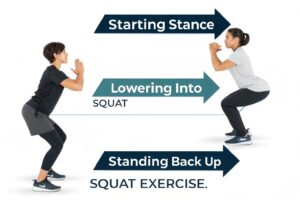If you’re searching for a proven way to build strength and boost metabolism, you’ve landed on the right page. In this comprehensive guide we break down the science‑backed movements that not only sculpt lean muscle but also keep your metabolic furnace burning long after you finish your workout. Let’s dive into the top five powerhouse exercises that will transform your body composition and elevate your everyday energy levels.
Strength training is more than just lifting heavy weights; it triggers hormonal responses that accelerate calorie burn, improves insulin sensitivity, and increases the amount of muscle tissue that requires energy at rest. By integrating the right exercises into a consistent routine, you’ll experience faster fat loss, stronger bones, and a higher basal metabolic rate (BMR). Below we explore each of the five essential lifts, complete with form cues, progression tips, and the metabolic mechanisms that make them so effective.
Why Compound Movements Are Metabolic Super‑Chargers
Multi‑Joint Activation Increases Energy Expenditure
Compound lifts such as squats, deadlifts, and presses recruit several muscle groups simultaneously. This broad recruitment forces the nervous system to work harder, which in turn spikes post‑exercise oxygen consumption (EPOC). The elevated EPOC means you continue burning calories for hours after the workout, a key factor for anyone looking to boost metabolism.
Hormonal Benefits of Heavy Loading
Heavy resistance training stimulates the release of testosterone, growth hormone, and catecholamines. These hormones not only support muscle hypertrophy but also enhance lipolysis—the breakdown of stored fat for energy. When you consistently perform compound movements, you cultivate a hormonal environment that favors a faster metabolic rate.
Exercise #1: Squat Variations – The King of Lower‑Body Strength
How Squats Ignite Metabolism
The squat engages the quadriceps, hamstrings, glutes, core, and even the upper back when performed with proper posture. Because the muscles involved are among the largest in the body, they consume a significant amount of oxygen and glucose, amplifying the metabolic response both during and after the set.

Proper Form for Maximum Benefit
1. Stand with feet shoulder‑width apart, toes slightly turned out.
2. Keep the chest up, shoulders back, and engage the core.
3. Initiate the movement by pushing the hips back as if sitting into a chair.
4. Descend until thighs are parallel to the floor (or lower if mobility permits).
5. Drive through the heels, extend the hips and knees simultaneously, and return to standing.
Progression Strategies
Start with bodyweight squats, then graduate to goblet squats, barbell back squats, and finally advanced variations like front squats, pause squats, or Bulgarian split squats. Adding tempo work (e.g., 3‑second eccentric phase) further intensifies metabolic stress.
Exercise #2: Deadlifts – Full‑Body Power for Metabolic Growth
Why Deadlifts Torch Calories
Deadlifts require you to lift a load from the ground to a standing position, demanding activation from the posterior chain (glutes, hamstrings, erector spinae), core, traps, and forearms. The sheer amount of weight moved in a short period creates a massive mechanical and metabolic load, spurring a pronounced after‑burn effect.
Step‑by‑Step Technique
1. Position feet hip‑width, bar over mid‑foot.
2. Grip the bar just outside the knees, either double overhand or mixed.
3. Keep the spine neutral, chest proud, and shoulders slightly in front of the bar.
4. Drive through the heels, extend hips and knees simultaneously, keeping the bar close to the shins.
5. Stand tall, squeezing glutes at the top, then lower the bar with control.
Variations & Load Management
Begin with the conventional deadlift, then explore Romanian deadlifts for hamstring emphasis, sumo deadlifts for reduced lumbar stress, and trap bar deadlifts for a more upright torso. Periodize your training by cycling between heavy (1–5 rep) and moderate (8–12 rep) loads to maintain metabolic stimulation.
Exercise #3: Overhead Press – Upper‑Body Strength that Fires Up the Core
Metabolic Impact of Vertical Pressing
Pressing a weight overhead recruits the deltoids, triceps, upper pecs, and the entire core for stabilization. The need maintain balance while driving the bar upward creates a high‑intensity, full‑body effort that elevates heart rate and boosts calorie burn.
Execution Guidelines
1. Set the bar at shoulder height, grip just outside the shoulders.
2. Keep elbows slightly in front of the bar, wrists neutral.
3. Engage the core and glutes to create a solid base.
4. Press the bar upward, following a slightly diagonal path (over the ears).
5. Lock out elbows, then lower the bar under control to the starting position.
Progression and Programming Tips
Start with a kettlebell or dumbbell press to master the movement, then transition to the barbell version. Incorporate push‑presses (using leg drive) to increase power and metabolic demand, and use drop sets or supersets with lateral raises for added hypertrophy.
Exercise #4: Bent‑Over Row – Building Back Strength for a Faster Metabolism
How Rows Enhance Caloric Burn
Rows target the lats, rhomboids, posterior deltoids, and biceps, while also demanding core activation to prevent spinal flexion. Training the back improves posture, which allows you to lift heavier compound lifts (like deadlifts and squats) with better form, indirectly supporting a higher metabolic rate.
Rowing Form Checklist
1. Hinge at the hips with a slight bend in the knees; torso almost parallel to the floor.
2. Grip the bar just outside the knees, palms facing you (underhand) or away (overhand).
3. Pull the bar toward the lower rib cage, squeezing the shoulder blades together.
4. Keep elbows close to the body and maintain a neutral spine throughout the motion.
5. Lower the bar slowly, resisting gravity to maximize time under tension.
Advanced Variations
After mastering the conventional barbell row, experiment with single‑arm dumbbell rows, chest‑supported rows, and Pendlay rows (starting each rep from the floor). These variations keep the stimulus fresh and continue to elevate metabolic demand.
Exercise #5: High‑Intensity Interval Training (HIIT) Sprints – The Metabolic Finisher

Why HIIT Complements Strength Workouts
Sprinting or bike sprints for short bursts (20‑30 seconds) followed by equal or slightly longer rest periods pushes the cardiovascular system to its limit. HIIT produces one of the highest EPOC responses among all exercise modalities, ensuring you burn calories long after the session ends.
Sample HIIT Blueprint
- Warm‑up: 5 minutes of dynamic stretching or light jogging.
- Work interval: 30 seconds all‑out sprint (track, treadmill, or bike).
- Rest interval: 60 seconds walk or slow pedal.
- Repeat: 8–10 cycles.
- Cool‑down: 5 minutes of easy movement and static stretching.
Integrating HIIT with the Top 5 Strength Moves
Place a 5‑minute HIIT finisher at the end of your strength sessions 2–3 times per week. The combination of heavy compound lifts plus a metabolic sprint ensures both muscular and cardiovascular systems are maximally taxed, accelerating fat loss and muscle retention.
Putting It All Together – A Sample Weekly Layout
Day‑by‑Day Schedule
Monday – Lower Body Focus: Back squat (4 × 6), Romanian deadlift (3 × 8), Bulgarian split squat (3 × 10 each leg), 5‑minute HIIT finisher.
Tuesday – Upper Body Push: Overhead press (4 × 6), incline dumbbell press (3 × 10), lateral raises (3 × 12), core circuit.
Wednesday – Active Recovery: Light cardio, mobility work, foam rolling.
Thursday – Pull & Posterior Chain: Conventional deadlift (4 × 5), bent‑over row (3 × 8), pull‑ups (3 × max), farmer’s walk.
Friday – Full‑Body Power: Front squat (3 × 5), push‑press (3 × 6), kettlebell swing (3 × 15), 5‑minute HIIT.
Saturday – Conditioning: Longer steady‑state cardio + mobility.
Sunday – Rest: Complete recovery.
Key Takeaways
-
- Focus on compound lifts that recruit large muscle groups.
-
- Maintain progressive overload – increase weight, reps, or tempo weekly.
-
- Incorporate HIIT to maximize EPOC and overall calorie burn.
Prioritize recovery: sleep, nutrition, and mobility are essential for metabolic health.
By consistently performing The Top 5 Exercises for Building Strength and Boosting Metabolism and pairing them with strategic HIIT sessions, you’ll experience a noticeable rise in basal metabolic rate, faster fat loss, and stronger, more resilient muscles. Start today, track your progress, and watch your body transform into a high‑efficiency metabolic machine.



